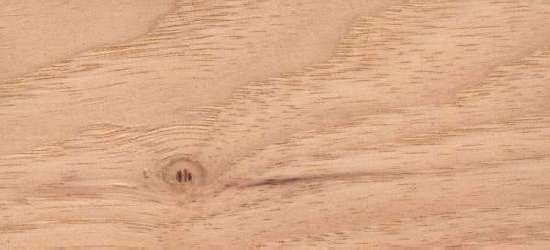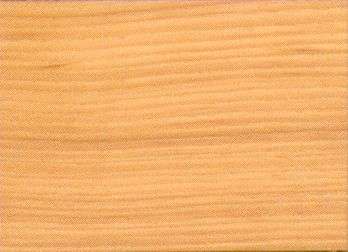 
Mockernut hickory (Carya spp.)
Family: Juglandaceae
Common names: Mockernut hickory, Pignut hickory, Shagbark hickory, Shellbark hickory, True hickory
Distributed in: Canada, United States (North America)
Common uses: Agricultural implements, Baseball bats, Boat building (general), Boxes and crates, Broom handles, Chairs, Charcoal, Cooperages, Fishing rods, Flooring, Fuelwood, Furniture, Handles: general, Ladders, Musical instruments, Plywood, Posts, Railroad ties, Skis, Sporting Goods, Textile equipment, Tool handles, Turnery, Vehicle parts, Veneer, Wheel spokes, Wheels
Colors: the heart isYellow, Yellow to golden-yellow to orangeand the sapwoodWhite, White to yellow.The grain isWavy, the textureMedium coarse to coarseand the lusterSlightly lustrous
Natural durability: Susceptible to attack from powder post (Lyctid & Bostrychid) beetles, Susceptible to attack from termites (Isoptera)
Kiln Schedules: UK=E US=T6D2/T3D1 Fr=5
Drying Defects: Moderate twist/warp, Slight surface checking
Ease of Drying: Reconditioning Treatement
Tree Identification: Bole/stem form is straight
Comments: General finishing qualities are rated as good
Blunting Effect: Blunting effect on machining is severe
Boring: Fairly easy to very easy
Carving: Fairly Easy to Very Easy
Gluing: Moderate gluing properties
Mortising: Fairly Easy to Very Easy
Moulding: Fairly Easy to Very Easy
Movement in Service: Fairly Easy to Very Easy
Nailing: Holds satisfactorily, Possible if prebored
Planing: Moderately easy to plane
Resistance to Impregnation: Heartwood is permeable
Resistance to Splitting: Poor
Response to hand tools: Moderate working qualities
Routing recessing: Fairly Easy to Very Easy
Veneering qualities: Easy to cut, There is slight to moderate drying degrade and the potential for buckles and splits
Steam bending: Very good
Screwing: Possible if prebored, Screwing yields good results; Turning: Good results
Polishing: Good;
- Numerical data Metric
- Numerical data English
- Strength properties
- References
 |
 |
 |
 |
| Item |
Green |
Dry |
Metric |
| Specific Gravity |
|
|
|
| Density |
|
769 |
kg/m3 |
| Bending Strength |
783 |
1216 |
kg/cm2 |
| Crushing Strength |
347 |
531 |
kg/cm2 |
| Hardness |
|
752 |
kg |
| Impact Strength |
|
187 |
cm |
| Shearing Strength |
|
155 |
kg/cm2 |
| Stiffness |
129 |
150 |
1000 kg/cm2 |
| Tangential Shrinkage |
|
|
% |
| Radial Shrinkage |
6 |
|
% |
| Weight |
753 |
608 |
kg/m3 |
| Maximum Load |
0,91 |
1,26 |
cm-kg/cm3 |
| Toughness |
|
|
cm-kg |
| Static Bending |
|
|
kg/cm2 |
|
 |  |  |  | | Item | Green | Dry | English | | Bending Strength | 11139 | 17304 | psi | | Density | | 48 | lbs/ft3 | | Hardness | | 1658 | lbs | | Impact Strength | | 74 | inches | | Maximum Crushing Strength | 4940 | 7563 | psi | | Shearing Strength | | 2205 | psi | | Stiffness | 1847 | 2140 | 1000 psi | | Work to Maximum Load | 13 | 18 | inch-lbs/in3 | | Weight | 47 | 38 | lbs/ft3 | | Radial Shrinkage | 6 | | % | | Tangential Shrinkage | 10 | | % | |
Density (dry weight) = 46-52 lbs/cu. ft. 0
Shearing strength (parallel to grain) = medium
Max. crushing strength = medium
Density (dry weight) = 53-60 lbs/cu. ft.
Modulus of Elasticity (stiffness) = medium
Bending strength (MOR) = medium
Max. crushing strength = high
Bending strength (MOR) = high
Hardness (side grain) = medium
Density (dry weight) = 38-45 lbs/cu. ft.
Toughness-Hammer drop (Impact Strength) = very high
Shrinkage, Tangential = large
Shrinkage, Radial = large
Modulus of Elasticity (stiffness) = very high
Max. crushing strength = low
Clifford, N.,1953,Commercial Hardwoods - Their Characteristics Identification and,Utilization,Sir Isaac Pitman & Sons Ltd. LondonCooper, G.P., Record, S.J.,1931,The Evergreen Forests of Liberia,Yale School Forestry Bulletin,31,pp1-153Farmer, R.H.,1972,Handbook of Hardwoods,HMSOForests Products Research Laboratory, U.K.,1956,A Handbook of Hardwoods,Forest Products Research Laboratory, Princes Risborough, Department of,Science and Industrial Research, Building Research EstablishmentGerhards, C.C.,1963,Some Strength and Related Properties of Green Wood of Hawaiian Eucalyptus,saligna,Forest Products Laboratory, Forest Service, U.S. Department of,Agriculture, Research Note No. FPL-09Howard, A.L.,1948,A Manual of Timbers of the World.,Macmillan & Co. Ltd. London 3rd ed.I.U.F.R.O.,1973,Veneer Species of the World,Assembled at F.P.L. Madison on behalf of I.U.F.R.O. Working Party on,Slicing and Veneer CuttingKloot, N.H., Bolza, E.,1961,Properties of Timbers Imported into Australia,C.S.I.R.O. Forest Products Division Technological Paper,No.12Mullins, E.J. and McKnight, T.S.,1981,Canadian Woods Their Properties and Uses,University of Toronto Press 3rd EditionPatterson, D.,1988,Commercial Timbers of the World, 5th Edition,Gower Technical PressPhillips, D.R.,1973,American Woods - Hickory,USDA, Forest Service American Woods FS-241Record, S.J., Hess, R.W.,1943,Timbers of the New World,Yale University PressRendle, B.J.,1969,World Timbers (3 Vols.,Ernest Benn Ltd. LondonTimber Development Association Ltd.,1955,World Timbers (3 Vols.,Timber Development Association Ltd.Titmuss, F.H.,1965,Commercial Timbers of the World,Technical Press Ltd., London, 3rd editionU.S.D.A. Forest Service,1974,Wood Handbook,U.S.A. Department of Agriculture, Forest Service Handbook,72Wangaard, F.F., et al,1954,Properties and Uses of Tropical Woods 4,Tropical Woods,14(99, pp1-187
|









